Discussing Professional Communication for Holistic Patient Care
VerifiedAdded on 2021/02/22
|7
|1977
|107
Essay
AI Summary
This essay explores the crucial role of professional communication in promoting holistic, patient-centred practice within healthcare, particularly in podiatric medicine. It emphasizes that effective communication is vital for acquiring patient information, ensuring accurate diagnoses, and facilitating clear treatment plans. The essay highlights key features of professional communication, including accuracy, clarity, distinctiveness, empathy, and continuity, and multi-channel approach. These features are essential for building trust, understanding patient needs, and enhancing adherence to treatment recommendations. By adopting these communication strategies, healthcare professionals can improve the quality of care, address diverse patient needs, and ultimately foster a more effective and patient-focused healthcare environment. The essay concludes that professional communication is indispensable for delivering effective podiatric medicine and adhering to a holistic patient-centred approach.
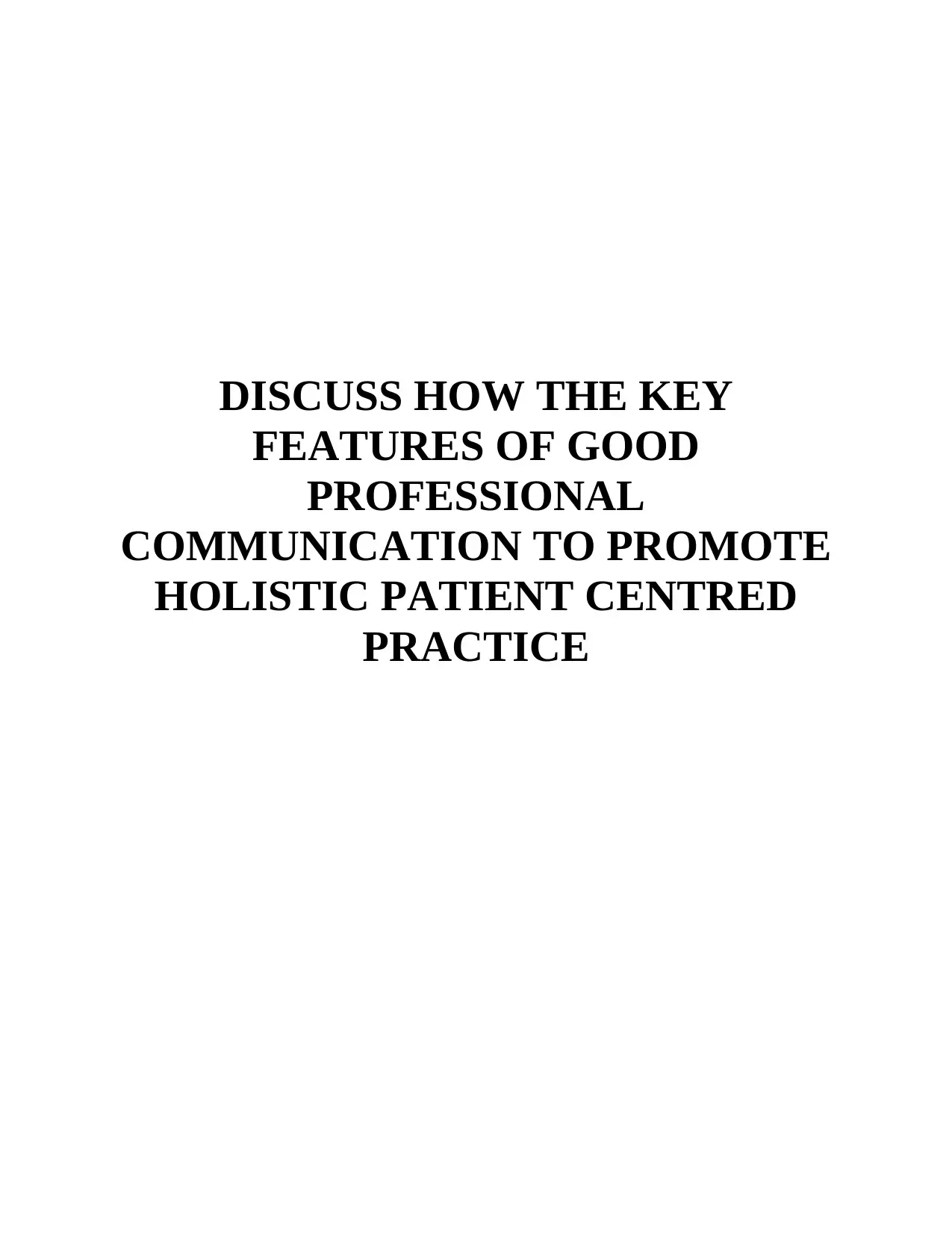
DISCUSS HOW THE KEY
FEATURES OF GOOD
PROFESSIONAL
COMMUNICATION TO PROMOTE
HOLISTIC PATIENT CENTRED
PRACTICE
FEATURES OF GOOD
PROFESSIONAL
COMMUNICATION TO PROMOTE
HOLISTIC PATIENT CENTRED
PRACTICE
Paraphrase This Document
Need a fresh take? Get an instant paraphrase of this document with our AI Paraphraser
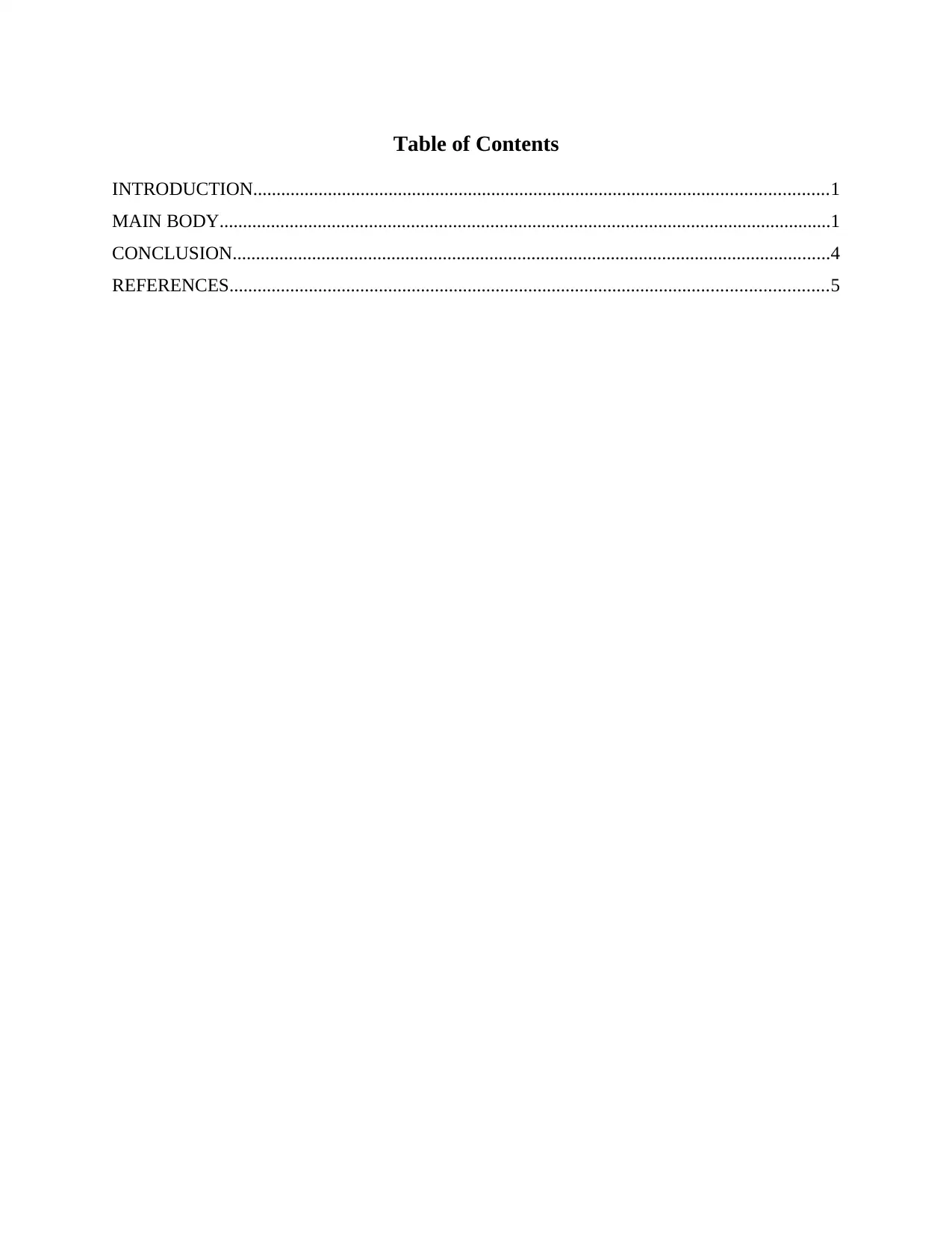
Table of Contents
INTRODUCTION...........................................................................................................................1
MAIN BODY...................................................................................................................................1
CONCLUSION................................................................................................................................4
REFERENCES................................................................................................................................5
INTRODUCTION...........................................................................................................................1
MAIN BODY...................................................................................................................................1
CONCLUSION................................................................................................................................4
REFERENCES................................................................................................................................5
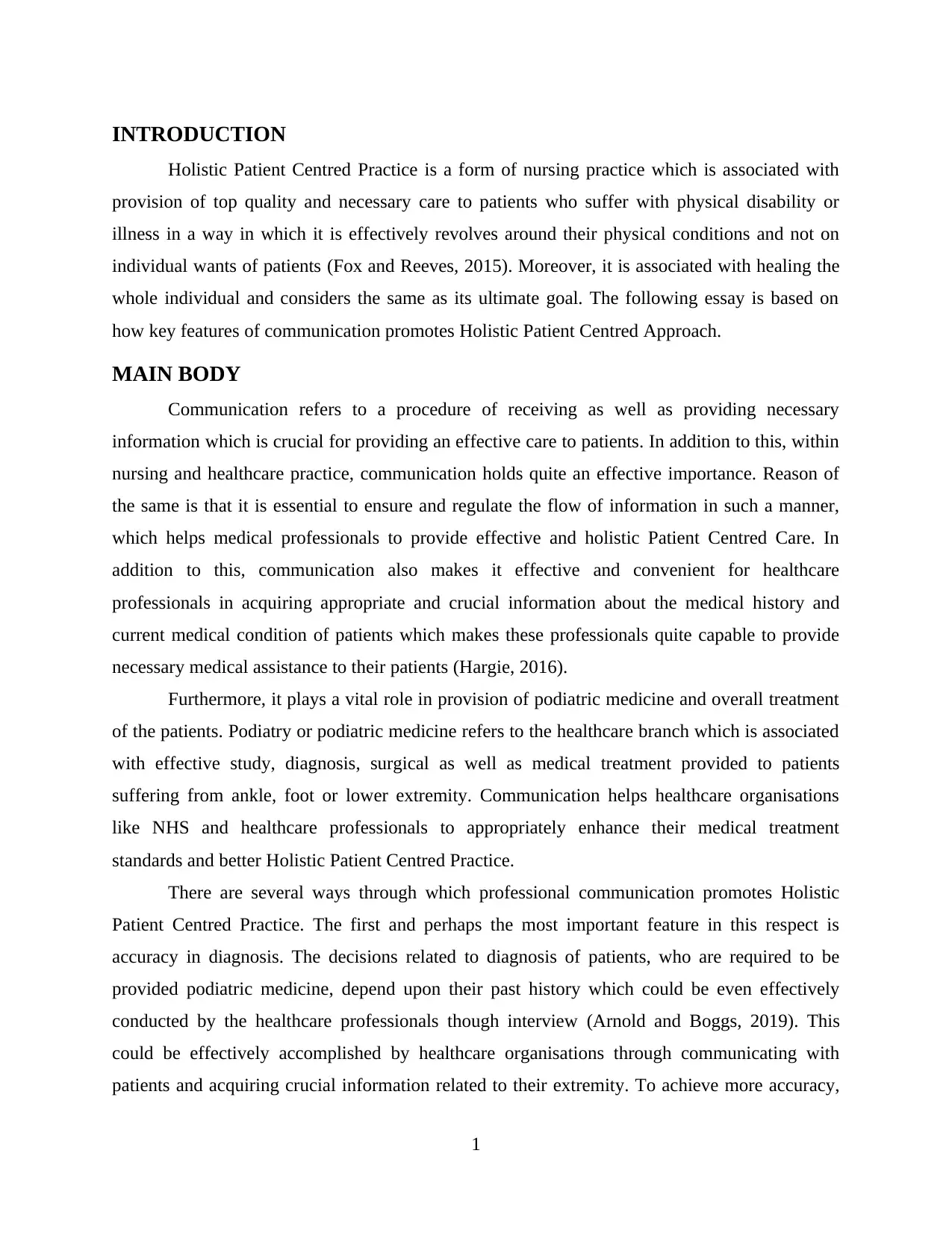
INTRODUCTION
Holistic Patient Centred Practice is a form of nursing practice which is associated with
provision of top quality and necessary care to patients who suffer with physical disability or
illness in a way in which it is effectively revolves around their physical conditions and not on
individual wants of patients (Fox and Reeves, 2015). Moreover, it is associated with healing the
whole individual and considers the same as its ultimate goal. The following essay is based on
how key features of communication promotes Holistic Patient Centred Approach.
MAIN BODY
Communication refers to a procedure of receiving as well as providing necessary
information which is crucial for providing an effective care to patients. In addition to this, within
nursing and healthcare practice, communication holds quite an effective importance. Reason of
the same is that it is essential to ensure and regulate the flow of information in such a manner,
which helps medical professionals to provide effective and holistic Patient Centred Care. In
addition to this, communication also makes it effective and convenient for healthcare
professionals in acquiring appropriate and crucial information about the medical history and
current medical condition of patients which makes these professionals quite capable to provide
necessary medical assistance to their patients (Hargie, 2016).
Furthermore, it plays a vital role in provision of podiatric medicine and overall treatment
of the patients. Podiatry or podiatric medicine refers to the healthcare branch which is associated
with effective study, diagnosis, surgical as well as medical treatment provided to patients
suffering from ankle, foot or lower extremity. Communication helps healthcare organisations
like NHS and healthcare professionals to appropriately enhance their medical treatment
standards and better Holistic Patient Centred Practice.
There are several ways through which professional communication promotes Holistic
Patient Centred Practice. The first and perhaps the most important feature in this respect is
accuracy in diagnosis. The decisions related to diagnosis of patients, who are required to be
provided podiatric medicine, depend upon their past history which could be even effectively
conducted by the healthcare professionals though interview (Arnold and Boggs, 2019). This
could be effectively accomplished by healthcare organisations through communicating with
patients and acquiring crucial information related to their extremity. To achieve more accuracy,
1
Holistic Patient Centred Practice is a form of nursing practice which is associated with
provision of top quality and necessary care to patients who suffer with physical disability or
illness in a way in which it is effectively revolves around their physical conditions and not on
individual wants of patients (Fox and Reeves, 2015). Moreover, it is associated with healing the
whole individual and considers the same as its ultimate goal. The following essay is based on
how key features of communication promotes Holistic Patient Centred Approach.
MAIN BODY
Communication refers to a procedure of receiving as well as providing necessary
information which is crucial for providing an effective care to patients. In addition to this, within
nursing and healthcare practice, communication holds quite an effective importance. Reason of
the same is that it is essential to ensure and regulate the flow of information in such a manner,
which helps medical professionals to provide effective and holistic Patient Centred Care. In
addition to this, communication also makes it effective and convenient for healthcare
professionals in acquiring appropriate and crucial information about the medical history and
current medical condition of patients which makes these professionals quite capable to provide
necessary medical assistance to their patients (Hargie, 2016).
Furthermore, it plays a vital role in provision of podiatric medicine and overall treatment
of the patients. Podiatry or podiatric medicine refers to the healthcare branch which is associated
with effective study, diagnosis, surgical as well as medical treatment provided to patients
suffering from ankle, foot or lower extremity. Communication helps healthcare organisations
like NHS and healthcare professionals to appropriately enhance their medical treatment
standards and better Holistic Patient Centred Practice.
There are several ways through which professional communication promotes Holistic
Patient Centred Practice. The first and perhaps the most important feature in this respect is
accuracy in diagnosis. The decisions related to diagnosis of patients, who are required to be
provided podiatric medicine, depend upon their past history which could be even effectively
conducted by the healthcare professionals though interview (Arnold and Boggs, 2019). This
could be effectively accomplished by healthcare organisations through communicating with
patients and acquiring crucial information related to their extremity. To achieve more accuracy,
1
⊘ This is a preview!⊘
Do you want full access?
Subscribe today to unlock all pages.

Trusted by 1+ million students worldwide
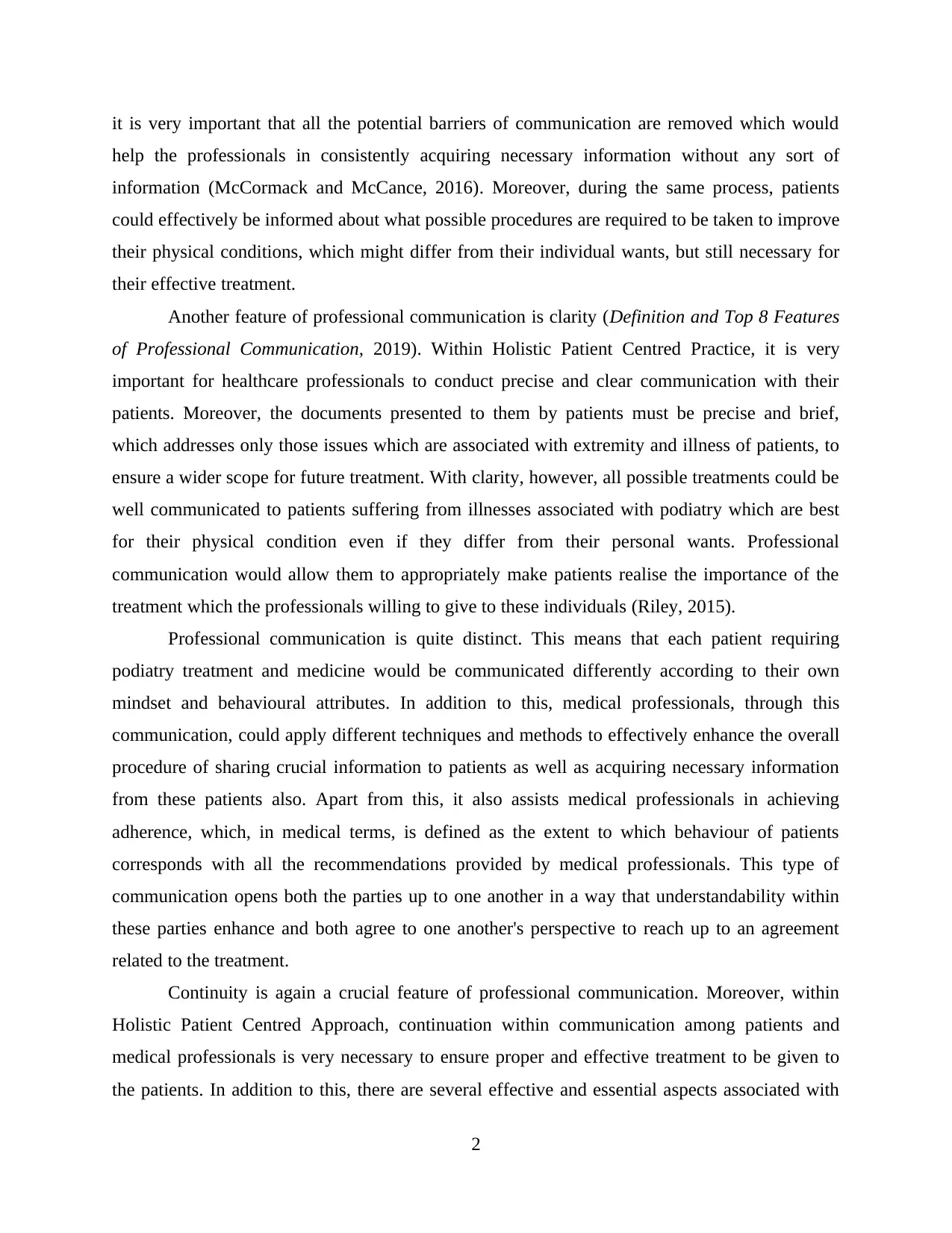
it is very important that all the potential barriers of communication are removed which would
help the professionals in consistently acquiring necessary information without any sort of
information (McCormack and McCance, 2016). Moreover, during the same process, patients
could effectively be informed about what possible procedures are required to be taken to improve
their physical conditions, which might differ from their individual wants, but still necessary for
their effective treatment.
Another feature of professional communication is clarity (Definition and Top 8 Features
of Professional Communication, 2019). Within Holistic Patient Centred Practice, it is very
important for healthcare professionals to conduct precise and clear communication with their
patients. Moreover, the documents presented to them by patients must be precise and brief,
which addresses only those issues which are associated with extremity and illness of patients, to
ensure a wider scope for future treatment. With clarity, however, all possible treatments could be
well communicated to patients suffering from illnesses associated with podiatry which are best
for their physical condition even if they differ from their personal wants. Professional
communication would allow them to appropriately make patients realise the importance of the
treatment which the professionals willing to give to these individuals (Riley, 2015).
Professional communication is quite distinct. This means that each patient requiring
podiatry treatment and medicine would be communicated differently according to their own
mindset and behavioural attributes. In addition to this, medical professionals, through this
communication, could apply different techniques and methods to effectively enhance the overall
procedure of sharing crucial information to patients as well as acquiring necessary information
from these patients also. Apart from this, it also assists medical professionals in achieving
adherence, which, in medical terms, is defined as the extent to which behaviour of patients
corresponds with all the recommendations provided by medical professionals. This type of
communication opens both the parties up to one another in a way that understandability within
these parties enhance and both agree to one another's perspective to reach up to an agreement
related to the treatment.
Continuity is again a crucial feature of professional communication. Moreover, within
Holistic Patient Centred Approach, continuation within communication among patients and
medical professionals is very necessary to ensure proper and effective treatment to be given to
the patients. In addition to this, there are several effective and essential aspects associated with
2
help the professionals in consistently acquiring necessary information without any sort of
information (McCormack and McCance, 2016). Moreover, during the same process, patients
could effectively be informed about what possible procedures are required to be taken to improve
their physical conditions, which might differ from their individual wants, but still necessary for
their effective treatment.
Another feature of professional communication is clarity (Definition and Top 8 Features
of Professional Communication, 2019). Within Holistic Patient Centred Practice, it is very
important for healthcare professionals to conduct precise and clear communication with their
patients. Moreover, the documents presented to them by patients must be precise and brief,
which addresses only those issues which are associated with extremity and illness of patients, to
ensure a wider scope for future treatment. With clarity, however, all possible treatments could be
well communicated to patients suffering from illnesses associated with podiatry which are best
for their physical condition even if they differ from their personal wants. Professional
communication would allow them to appropriately make patients realise the importance of the
treatment which the professionals willing to give to these individuals (Riley, 2015).
Professional communication is quite distinct. This means that each patient requiring
podiatry treatment and medicine would be communicated differently according to their own
mindset and behavioural attributes. In addition to this, medical professionals, through this
communication, could apply different techniques and methods to effectively enhance the overall
procedure of sharing crucial information to patients as well as acquiring necessary information
from these patients also. Apart from this, it also assists medical professionals in achieving
adherence, which, in medical terms, is defined as the extent to which behaviour of patients
corresponds with all the recommendations provided by medical professionals. This type of
communication opens both the parties up to one another in a way that understandability within
these parties enhance and both agree to one another's perspective to reach up to an agreement
related to the treatment.
Continuity is again a crucial feature of professional communication. Moreover, within
Holistic Patient Centred Approach, continuation within communication among patients and
medical professionals is very necessary to ensure proper and effective treatment to be given to
the patients. In addition to this, there are several effective and essential aspects associated with
2
Paraphrase This Document
Need a fresh take? Get an instant paraphrase of this document with our AI Paraphraser
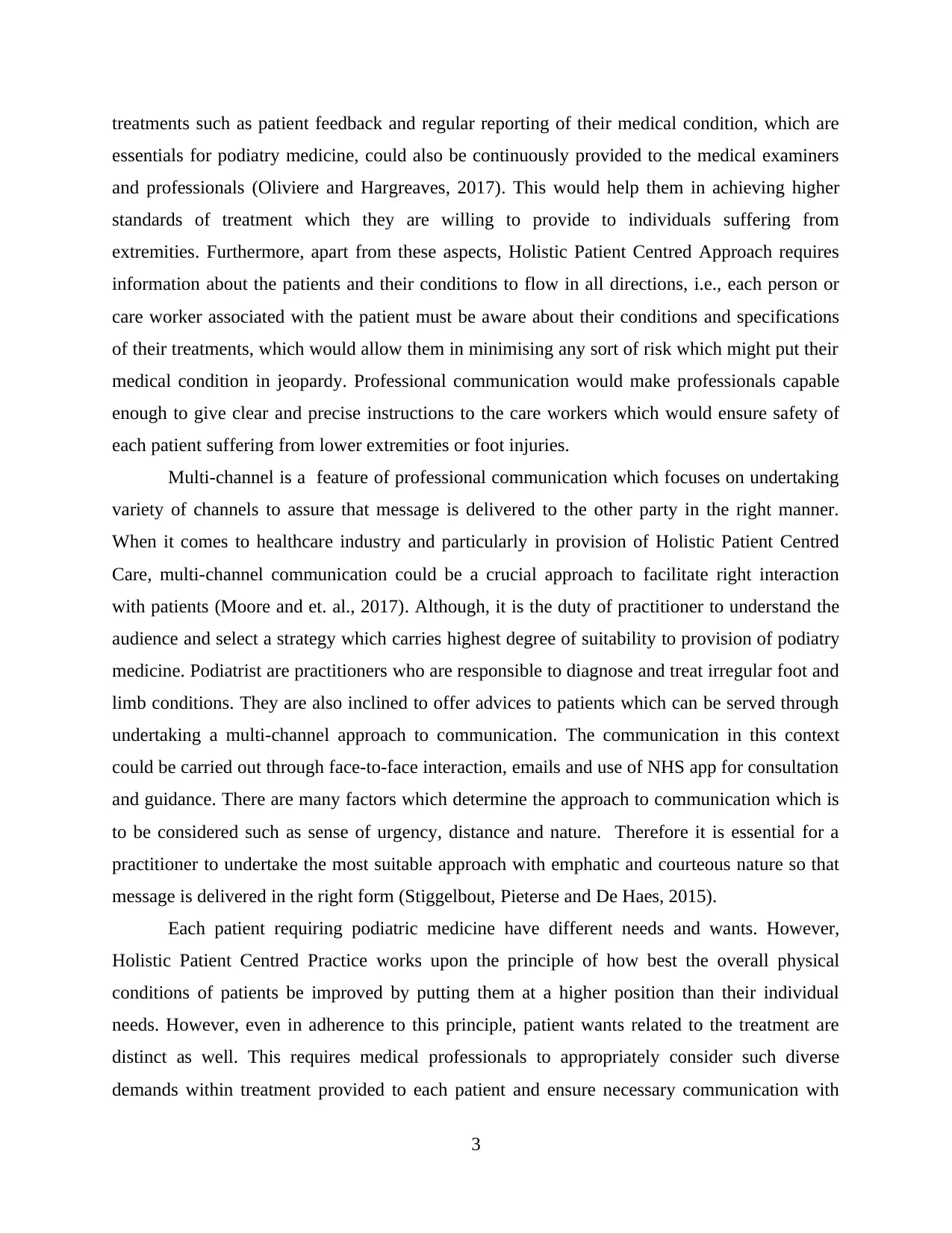
treatments such as patient feedback and regular reporting of their medical condition, which are
essentials for podiatry medicine, could also be continuously provided to the medical examiners
and professionals (Oliviere and Hargreaves, 2017). This would help them in achieving higher
standards of treatment which they are willing to provide to individuals suffering from
extremities. Furthermore, apart from these aspects, Holistic Patient Centred Approach requires
information about the patients and their conditions to flow in all directions, i.e., each person or
care worker associated with the patient must be aware about their conditions and specifications
of their treatments, which would allow them in minimising any sort of risk which might put their
medical condition in jeopardy. Professional communication would make professionals capable
enough to give clear and precise instructions to the care workers which would ensure safety of
each patient suffering from lower extremities or foot injuries.
Multi-channel is a feature of professional communication which focuses on undertaking
variety of channels to assure that message is delivered to the other party in the right manner.
When it comes to healthcare industry and particularly in provision of Holistic Patient Centred
Care, multi-channel communication could be a crucial approach to facilitate right interaction
with patients (Moore and et. al., 2017). Although, it is the duty of practitioner to understand the
audience and select a strategy which carries highest degree of suitability to provision of podiatry
medicine. Podiatrist are practitioners who are responsible to diagnose and treat irregular foot and
limb conditions. They are also inclined to offer advices to patients which can be served through
undertaking a multi-channel approach to communication. The communication in this context
could be carried out through face-to-face interaction, emails and use of NHS app for consultation
and guidance. There are many factors which determine the approach to communication which is
to be considered such as sense of urgency, distance and nature. Therefore it is essential for a
practitioner to undertake the most suitable approach with emphatic and courteous nature so that
message is delivered in the right form (Stiggelbout, Pieterse and De Haes, 2015).
Each patient requiring podiatric medicine have different needs and wants. However,
Holistic Patient Centred Practice works upon the principle of how best the overall physical
conditions of patients be improved by putting them at a higher position than their individual
needs. However, even in adherence to this principle, patient wants related to the treatment are
distinct as well. This requires medical professionals to appropriately consider such diverse
demands within treatment provided to each patient and ensure necessary communication with
3
essentials for podiatry medicine, could also be continuously provided to the medical examiners
and professionals (Oliviere and Hargreaves, 2017). This would help them in achieving higher
standards of treatment which they are willing to provide to individuals suffering from
extremities. Furthermore, apart from these aspects, Holistic Patient Centred Approach requires
information about the patients and their conditions to flow in all directions, i.e., each person or
care worker associated with the patient must be aware about their conditions and specifications
of their treatments, which would allow them in minimising any sort of risk which might put their
medical condition in jeopardy. Professional communication would make professionals capable
enough to give clear and precise instructions to the care workers which would ensure safety of
each patient suffering from lower extremities or foot injuries.
Multi-channel is a feature of professional communication which focuses on undertaking
variety of channels to assure that message is delivered to the other party in the right manner.
When it comes to healthcare industry and particularly in provision of Holistic Patient Centred
Care, multi-channel communication could be a crucial approach to facilitate right interaction
with patients (Moore and et. al., 2017). Although, it is the duty of practitioner to understand the
audience and select a strategy which carries highest degree of suitability to provision of podiatry
medicine. Podiatrist are practitioners who are responsible to diagnose and treat irregular foot and
limb conditions. They are also inclined to offer advices to patients which can be served through
undertaking a multi-channel approach to communication. The communication in this context
could be carried out through face-to-face interaction, emails and use of NHS app for consultation
and guidance. There are many factors which determine the approach to communication which is
to be considered such as sense of urgency, distance and nature. Therefore it is essential for a
practitioner to undertake the most suitable approach with emphatic and courteous nature so that
message is delivered in the right form (Stiggelbout, Pieterse and De Haes, 2015).
Each patient requiring podiatric medicine have different needs and wants. However,
Holistic Patient Centred Practice works upon the principle of how best the overall physical
conditions of patients be improved by putting them at a higher position than their individual
needs. However, even in adherence to this principle, patient wants related to the treatment are
distinct as well. This requires medical professionals to appropriately consider such diverse
demands within treatment provided to each patient and ensure necessary communication with
3
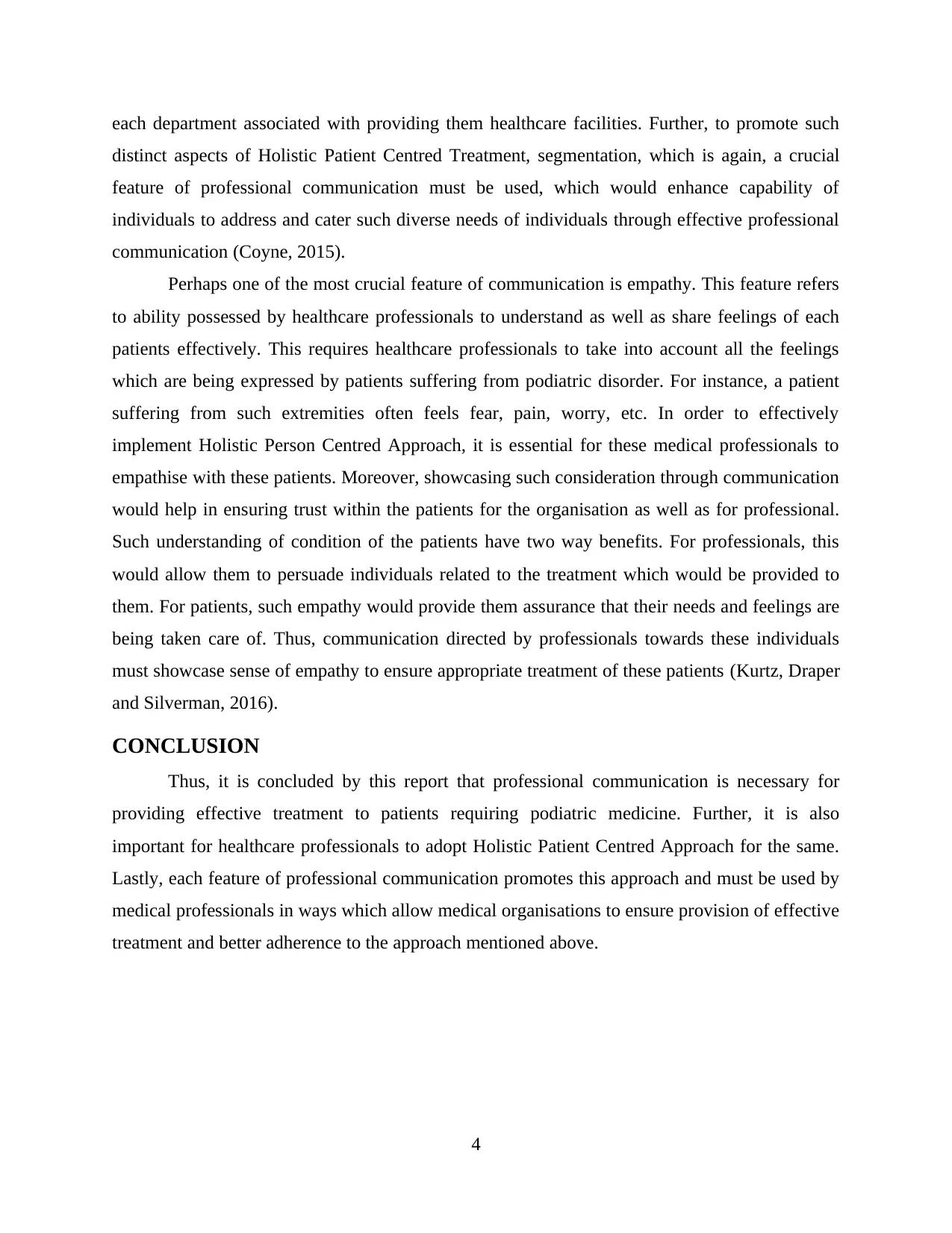
each department associated with providing them healthcare facilities. Further, to promote such
distinct aspects of Holistic Patient Centred Treatment, segmentation, which is again, a crucial
feature of professional communication must be used, which would enhance capability of
individuals to address and cater such diverse needs of individuals through effective professional
communication (Coyne, 2015).
Perhaps one of the most crucial feature of communication is empathy. This feature refers
to ability possessed by healthcare professionals to understand as well as share feelings of each
patients effectively. This requires healthcare professionals to take into account all the feelings
which are being expressed by patients suffering from podiatric disorder. For instance, a patient
suffering from such extremities often feels fear, pain, worry, etc. In order to effectively
implement Holistic Person Centred Approach, it is essential for these medical professionals to
empathise with these patients. Moreover, showcasing such consideration through communication
would help in ensuring trust within the patients for the organisation as well as for professional.
Such understanding of condition of the patients have two way benefits. For professionals, this
would allow them to persuade individuals related to the treatment which would be provided to
them. For patients, such empathy would provide them assurance that their needs and feelings are
being taken care of. Thus, communication directed by professionals towards these individuals
must showcase sense of empathy to ensure appropriate treatment of these patients (Kurtz, Draper
and Silverman, 2016).
CONCLUSION
Thus, it is concluded by this report that professional communication is necessary for
providing effective treatment to patients requiring podiatric medicine. Further, it is also
important for healthcare professionals to adopt Holistic Patient Centred Approach for the same.
Lastly, each feature of professional communication promotes this approach and must be used by
medical professionals in ways which allow medical organisations to ensure provision of effective
treatment and better adherence to the approach mentioned above.
4
distinct aspects of Holistic Patient Centred Treatment, segmentation, which is again, a crucial
feature of professional communication must be used, which would enhance capability of
individuals to address and cater such diverse needs of individuals through effective professional
communication (Coyne, 2015).
Perhaps one of the most crucial feature of communication is empathy. This feature refers
to ability possessed by healthcare professionals to understand as well as share feelings of each
patients effectively. This requires healthcare professionals to take into account all the feelings
which are being expressed by patients suffering from podiatric disorder. For instance, a patient
suffering from such extremities often feels fear, pain, worry, etc. In order to effectively
implement Holistic Person Centred Approach, it is essential for these medical professionals to
empathise with these patients. Moreover, showcasing such consideration through communication
would help in ensuring trust within the patients for the organisation as well as for professional.
Such understanding of condition of the patients have two way benefits. For professionals, this
would allow them to persuade individuals related to the treatment which would be provided to
them. For patients, such empathy would provide them assurance that their needs and feelings are
being taken care of. Thus, communication directed by professionals towards these individuals
must showcase sense of empathy to ensure appropriate treatment of these patients (Kurtz, Draper
and Silverman, 2016).
CONCLUSION
Thus, it is concluded by this report that professional communication is necessary for
providing effective treatment to patients requiring podiatric medicine. Further, it is also
important for healthcare professionals to adopt Holistic Patient Centred Approach for the same.
Lastly, each feature of professional communication promotes this approach and must be used by
medical professionals in ways which allow medical organisations to ensure provision of effective
treatment and better adherence to the approach mentioned above.
4
⊘ This is a preview!⊘
Do you want full access?
Subscribe today to unlock all pages.

Trusted by 1+ million students worldwide
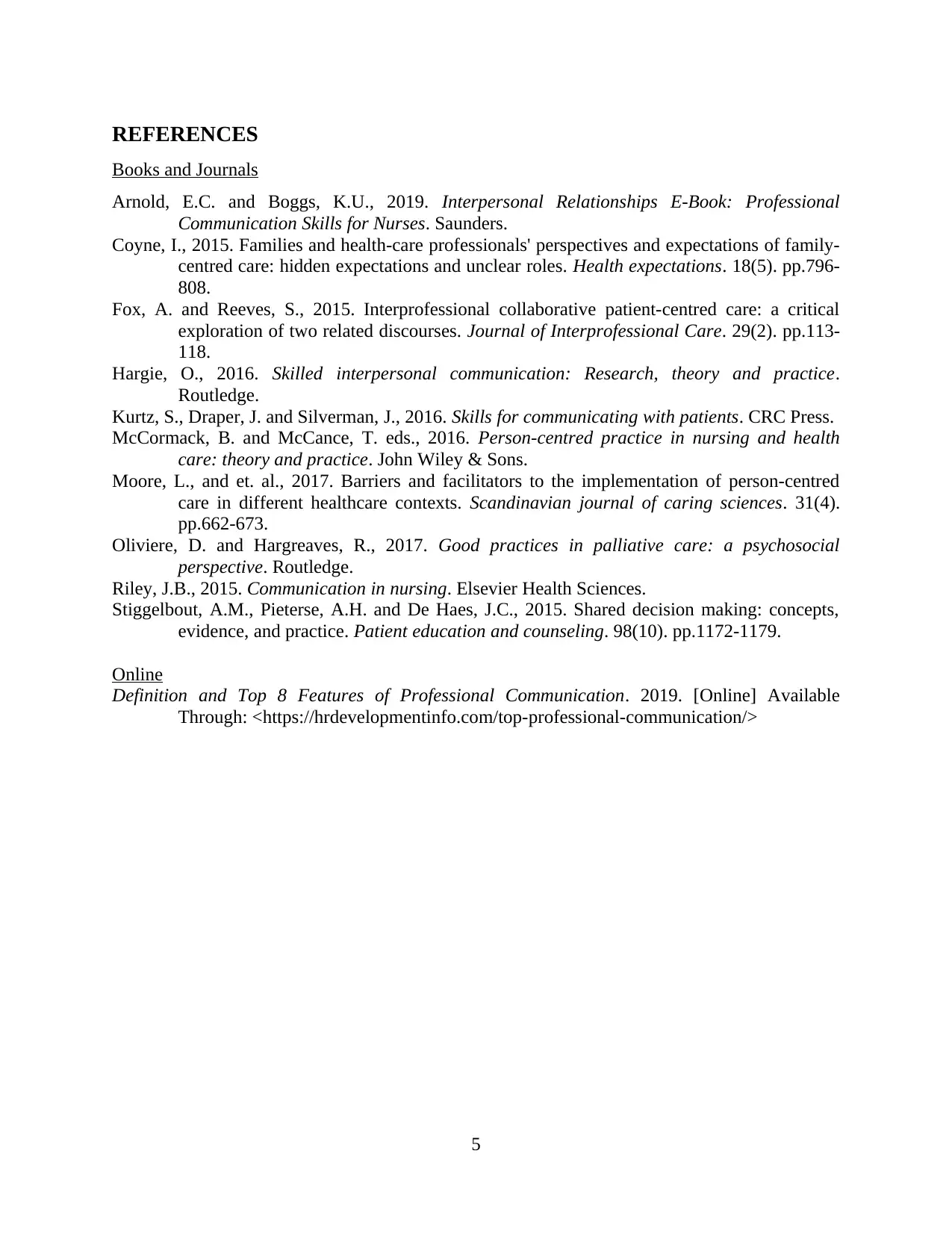
REFERENCES
Books and Journals
Arnold, E.C. and Boggs, K.U., 2019. Interpersonal Relationships E-Book: Professional
Communication Skills for Nurses. Saunders.
Coyne, I., 2015. Families and health‐care professionals' perspectives and expectations of family‐
centred care: hidden expectations and unclear roles. Health expectations. 18(5). pp.796-
808.
Fox, A. and Reeves, S., 2015. Interprofessional collaborative patient-centred care: a critical
exploration of two related discourses. Journal of Interprofessional Care. 29(2). pp.113-
118.
Hargie, O., 2016. Skilled interpersonal communication: Research, theory and practice.
Routledge.
Kurtz, S., Draper, J. and Silverman, J., 2016. Skills for communicating with patients. CRC Press.
McCormack, B. and McCance, T. eds., 2016. Person-centred practice in nursing and health
care: theory and practice. John Wiley & Sons.
Moore, L., and et. al., 2017. Barriers and facilitators to the implementation of person‐centred
care in different healthcare contexts. Scandinavian journal of caring sciences. 31(4).
pp.662-673.
Oliviere, D. and Hargreaves, R., 2017. Good practices in palliative care: a psychosocial
perspective. Routledge.
Riley, J.B., 2015. Communication in nursing. Elsevier Health Sciences.
Stiggelbout, A.M., Pieterse, A.H. and De Haes, J.C., 2015. Shared decision making: concepts,
evidence, and practice. Patient education and counseling. 98(10). pp.1172-1179.
Online
Definition and Top 8 Features of Professional Communication. 2019. [Online] Available
Through: <https://hrdevelopmentinfo.com/top-professional-communication/>
5
Books and Journals
Arnold, E.C. and Boggs, K.U., 2019. Interpersonal Relationships E-Book: Professional
Communication Skills for Nurses. Saunders.
Coyne, I., 2015. Families and health‐care professionals' perspectives and expectations of family‐
centred care: hidden expectations and unclear roles. Health expectations. 18(5). pp.796-
808.
Fox, A. and Reeves, S., 2015. Interprofessional collaborative patient-centred care: a critical
exploration of two related discourses. Journal of Interprofessional Care. 29(2). pp.113-
118.
Hargie, O., 2016. Skilled interpersonal communication: Research, theory and practice.
Routledge.
Kurtz, S., Draper, J. and Silverman, J., 2016. Skills for communicating with patients. CRC Press.
McCormack, B. and McCance, T. eds., 2016. Person-centred practice in nursing and health
care: theory and practice. John Wiley & Sons.
Moore, L., and et. al., 2017. Barriers and facilitators to the implementation of person‐centred
care in different healthcare contexts. Scandinavian journal of caring sciences. 31(4).
pp.662-673.
Oliviere, D. and Hargreaves, R., 2017. Good practices in palliative care: a psychosocial
perspective. Routledge.
Riley, J.B., 2015. Communication in nursing. Elsevier Health Sciences.
Stiggelbout, A.M., Pieterse, A.H. and De Haes, J.C., 2015. Shared decision making: concepts,
evidence, and practice. Patient education and counseling. 98(10). pp.1172-1179.
Online
Definition and Top 8 Features of Professional Communication. 2019. [Online] Available
Through: <https://hrdevelopmentinfo.com/top-professional-communication/>
5
1 out of 7
Related Documents
Your All-in-One AI-Powered Toolkit for Academic Success.
+13062052269
info@desklib.com
Available 24*7 on WhatsApp / Email
![[object Object]](/_next/static/media/star-bottom.7253800d.svg)
Unlock your academic potential
Copyright © 2020–2025 A2Z Services. All Rights Reserved. Developed and managed by ZUCOL.





